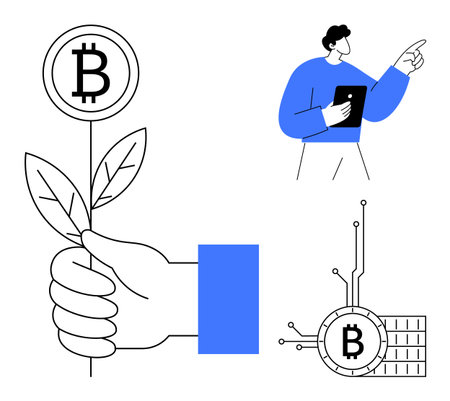1. Introduction: Setting the Stage for U.S. Pension Plans
Pension plans have long played a pivotal role in shaping the financial security of American workers after retirement. Historically, traditional defined benefit plans—commonly known as pensions—were a cornerstone of retirement planning, often provided by large employers and guaranteeing a steady income stream for life. Over the past few decades, however, the landscape has shifted dramatically. Today, fewer private-sector workers have access to these classic pension arrangements, with many employers transitioning to defined contribution plans such as 401(k)s. This evolution reflects broader economic, demographic, and regulatory changes that continue to influence how Americans save for their golden years. As we look ahead, understanding where pension plans stand today—and how they arrived here—is essential for navigating the challenges and opportunities that lie on the horizon.
2. Key Trends Shaping the Future of Pension Plans
As we look toward the future of pension plans in the United States, several significant trends are emerging that will shape how both public and private systems evolve. Understanding these key factors is essential for anyone planning their retirement or managing employee benefits. Let’s break down the demographic, economic, and policy shifts influencing the landscape.
Demographic Shifts: An Aging Population
The U.S. population is aging rapidly as Baby Boomers continue to retire and life expectancy increases. This puts pressure on pension systems, which must support a growing number of retirees for longer periods. The ratio of workers to retirees is shrinking, raising questions about long-term sustainability.
| Year | Workers per Retiree |
|---|---|
| 2000 | 4.7 |
| 2020 | 3.5 |
| 2040 (projected) | 2.5 |
Economic Realities: Market Volatility and Low Interest Rates
Pension funds have traditionally relied on stable investment returns to meet their obligations. However, ongoing market volatility and persistently low interest rates make it harder for both public and private plans to generate sufficient growth. This reality has forced many employers to reconsider plan structures and contribution levels.
Impact on Pension Funding Status
| Pension Plan Type | % Funded (2023) | Main Economic Challenge |
|---|---|---|
| Public Sector Plans | 76% | State budget constraints, investment risk |
| Private Sector Plans | 91% | Market volatility, regulatory changes |
Policy Developments: Regulatory Changes and New Opportunities
The legislative environment continues to evolve with measures like the SECURE Act and proposed Social Security reforms. These policies aim to expand retirement savings access, encourage employer participation, and provide more flexibility in plan offerings—benefiting workers but also increasing compliance complexity for sponsors.
Recent Policy Initiatives Affecting Pension Plans
- SECURE 2.0 Act: Expands automatic enrollment options and raises catch-up contribution limits for older workers.
- State-Facilitated Retirement Programs: More states are introducing auto-IRA programs for employees without workplace pensions.
- Pension Risk Transfers: Employers increasingly transfer pension liabilities to insurance companies through annuity purchases.
Together, these demographic, economic, and policy trends are shaping the next chapter of pension planning in America—making adaptability and proactive financial planning more important than ever for individuals and organizations alike.

3. Unique Challenges Facing Pension Plans Today
Pension plans in the United States are facing a set of unique challenges that are shaping their future and impacting both employers and employees. One of the most pressing issues is funding shortfalls. Many traditional pension funds, especially those managed by public institutions, are struggling to keep up with their long-term liabilities. Market volatility, lower-than-expected investment returns, and underestimating future obligations have led to significant gaps between what has been promised and what is actually available to pay retirees.
Longevity Risk: Americans Are Living Longer
Another key challenge is longevity risk. With advancements in healthcare and improved living standards, Americans are living longer than ever before. While this is great news for individuals and families, it puts additional strain on pension plans that must provide income over an extended retirement period. This increased life expectancy means that plan sponsors need to stretch their resources further, often without corresponding increases in contributions or returns.
The Shift from Defined Benefit to Defined Contribution Plans
Compounding these issues is the ongoing shift from defined benefit (DB) plans to defined contribution (DC) plans, such as 401(k)s. In a DB plan, retirees receive a predetermined payout based on salary and years of service. These plans put the investment risk on employers, who must ensure there are enough funds to meet their obligations. However, due to rising costs and regulatory pressures, many employers have transitioned to DC plans where employees bear the investment risk. While DC plans offer more flexibility and portability for workers, they also require individuals to take greater responsibility for managing their retirement savings, often without sufficient financial education or planning support.
Navigating an Uncertain Future
These challenges—underfunding, longevity risk, and the move toward defined contribution—highlight the complexity of today’s pension landscape. For both employers and employees, understanding these risks is essential for effective retirement planning. It’s more important than ever for individuals to educate themselves about their options and for organizations to seek sustainable solutions that balance financial security with changing economic realities.
4. Opportunities for Innovation and Growth
As the landscape of pension plans in the U.S. evolves, there are exciting opportunities for innovation and growth that can help bolster retirement security for millions of Americans. Technology, public policy reforms, and emerging savings vehicles are at the forefront of this transformation, offering solutions to some of the most pressing challenges facing retirement planning today.
Embracing Technology in Retirement Planning
Digital tools and fintech platforms have revolutionized how people save, invest, and manage their retirement accounts. Robo-advisors, personalized financial planning apps, and automated contribution tracking make it easier for individuals to take control of their financial futures. These technologies not only increase accessibility but also offer educational resources tailored to diverse needs, helping bridge the retirement savings gap across different demographic groups.
Public Policy Reforms Driving Change
Recent legislative initiatives such as the SECURE Act and proposed enhancements like SECURE 2.0 reflect a growing commitment to strengthening America’s retirement system. By expanding automatic enrollment, increasing catch-up contribution limits, and making it easier for small businesses to offer retirement plans, these policy changes aim to make saving for retirement more inclusive and effective.
Key Public Policy Innovations
| Policy Reform | Main Benefit | Who Benefits? |
|---|---|---|
| Automatic Enrollment | Increases participation rates in 401(k) plans | All employees, especially younger workers |
| SECURE Act & SECURE 2.0 | Improves access and flexibility in retirement savings | Small business employees, part-time workers, older savers |
| State-Sponsored IRA Programs | Offers retirement plan options where none exist | Gig workers, self-employed, those without employer plans |
New Savings Vehicles Expanding Choices
The rise of new savings products—such as Roth IRAs with higher income thresholds, health savings accounts (HSAs) used as supplemental retirement funds, and pooled employer plans (PEPs)—broadens Americans’ options for building wealth over time. Employers are also exploring student loan repayment benefits tied to retirement contributions and flexible payout options that address longevity risk.
A Brighter Future for American Retirees
Together, these innovations point toward a future where more people can achieve financial independence in retirement. By leveraging technology, advocating for smart policy reforms, and embracing new ways to save, both individuals and employers can play a pivotal role in creating a more secure and prosperous retirement landscape for all Americans.
5. Impact on American Workers and Retirees
The shifting landscape of pension plans in the U.S. has a profound impact on the financial wellness and retirement outlook for millions of Americans. As traditional defined benefit (DB) pensions become less common, more workers are left to navigate the complexities of defined contribution (DC) plans like 401(k)s or IRAs. This transition places greater responsibility—and risk—on individuals to save, invest, and plan for their own futures.
Changing Roles: From Employers to Individuals
Decades ago, many American workers could count on a stable pension after years of service. Today, most workers must take an active role in managing their retirement savings. While DC plans offer portability and flexibility, they also require financial literacy and proactive decision-making that not everyone feels prepared for. The shift means employees must balance current living expenses with future needs, sometimes leading to under-saving or mismanaging investments.
Financial Wellness: Opportunities and Challenges
This evolving environment creates both opportunities and challenges. On one hand, Americans have more control over how their retirement funds are invested and can tailor their strategies to fit personal goals. On the other hand, market volatility, changing interest rates, and longer lifespans make it harder to predict if savings will last throughout retirement. Many workers express anxiety about outliving their assets or facing unexpected healthcare costs.
Long-Term Planning: A New Reality
With these changes, long-term retirement planning is more crucial than ever. Everyday Americans need to start saving earlier, contribute consistently, and seek guidance on investment options. The rise of online tools and professional financial advisors can help bridge knowledge gaps—but only for those who seek them out. For lower-income workers or those without employer-sponsored plans, building sufficient savings remains a significant hurdle.
Ultimately, the new pension reality in the U.S. demands increased awareness and proactive planning from workers at every stage of their careers. By understanding these trends and taking advantage of available resources, Americans can position themselves for a more secure financial future despite the challenges ahead.
6. Strategies for a Secure Retirement Future
As pension plans in the U.S. continue to evolve, it’s more important than ever for individuals to take proactive steps toward securing their financial future. Navigating these changes can feel overwhelming, but with some practical guidance and smart planning, you can maximize your retirement benefits and build confidence about your golden years.
Stay Informed About Pension Changes
Pension policies and employer offerings are constantly shifting. Stay up-to-date by regularly reviewing your plan details, checking updates from your HR department, and consulting trusted news sources. Understanding how legislative changes or plan amendments might affect your benefits allows you to make timely decisions.
Diversify Your Retirement Savings
Don’t rely solely on your pension. Supplement your retirement income with personal savings vehicles such as 401(k)s, IRAs, or Roth IRAs. Contribute consistently, and take advantage of employer matching programs when available—this is essentially free money for your future.
Maximize Employer Contributions
If you have access to a 401(k) or similar plan, contribute at least enough to receive the full employer match. Over time, these contributions and the power of compounding can significantly enhance your retirement nest egg.
Consider Your Social Security Strategy
Social Security remains an essential piece of most Americans’ retirement puzzle. Delaying benefits until full retirement age (or even age 70) can substantially increase your monthly payments. Evaluate the best timing based on your health, family longevity, and financial needs.
Create a Personalized Financial Plan
Meet with a certified financial planner who understands the nuances of U.S. pension systems. Together, map out a plan that factors in all your sources of retirement income, anticipated expenses, tax implications, and healthcare needs.
Embrace Ongoing Education
The world of pensions and retirement planning doesn’t stand still. Attend workshops, webinars, or community classes to stay sharp on financial best practices. Knowledge truly is power when it comes to making informed choices about your future.
Prepare for Contingencies
No plan is complete without considering “what if” scenarios—such as market downturns or unexpected medical expenses. Build an emergency fund and consider products like long-term care insurance to help shield your savings from life’s surprises.
By staying engaged and taking these strategic steps, you’ll be better prepared to adapt to the changing landscape of pension plans in the U.S.—and enjoy greater peace of mind as you approach retirement.
7. Conclusion: Looking Ahead
As we reflect on the evolving landscape of pension plans in the U.S., several key insights stand out. The shift from traditional defined benefit pensions to defined contribution plans, such as 401(k)s and IRAs, highlights a growing need for individual responsibility and financial literacy in retirement planning. While this transition brings greater flexibility and control, it also poses challenges—like increased market risk and the potential for inadequate savings if not managed proactively.
Given these ongoing changes, it’s essential for Americans to stay informed and engaged with their retirement strategies. Understanding your options, staying updated on legislative developments, and regularly reviewing your retirement plan can help you adapt to new trends and seize emerging opportunities. Collaborating with trusted financial advisors or utilizing online resources can provide tailored guidance to maximize your long-term security.
Looking ahead, the future of pension plans will likely continue to be shaped by economic shifts, policy reforms, and advances in financial technology. By embracing proactive engagement—whether that means increasing contributions, diversifying investments, or seeking professional advice—you can better navigate uncertainties and build a more confident path toward a comfortable retirement. Remember, the earlier you start planning and the more intentional you are with your strategy, the better positioned you’ll be to achieve lasting financial well-being in your golden years.


